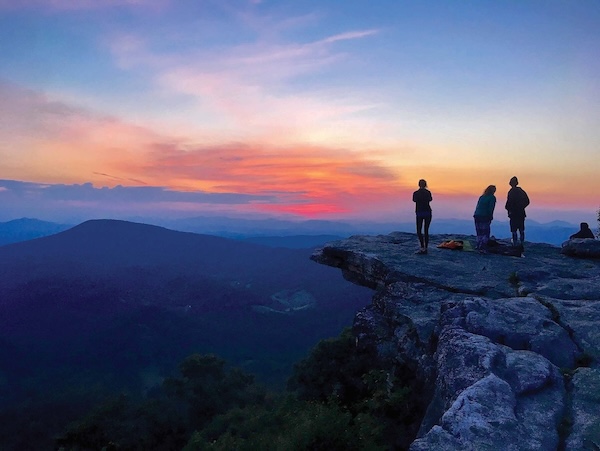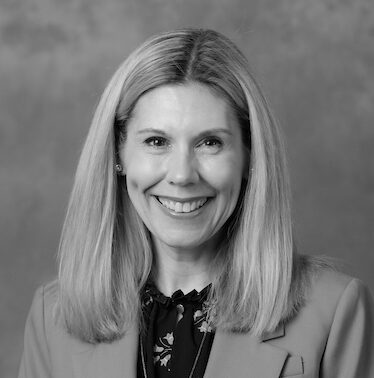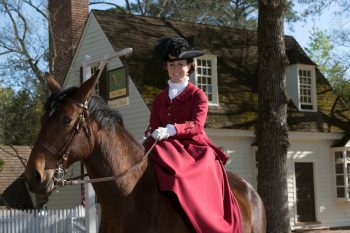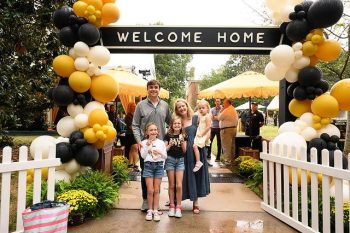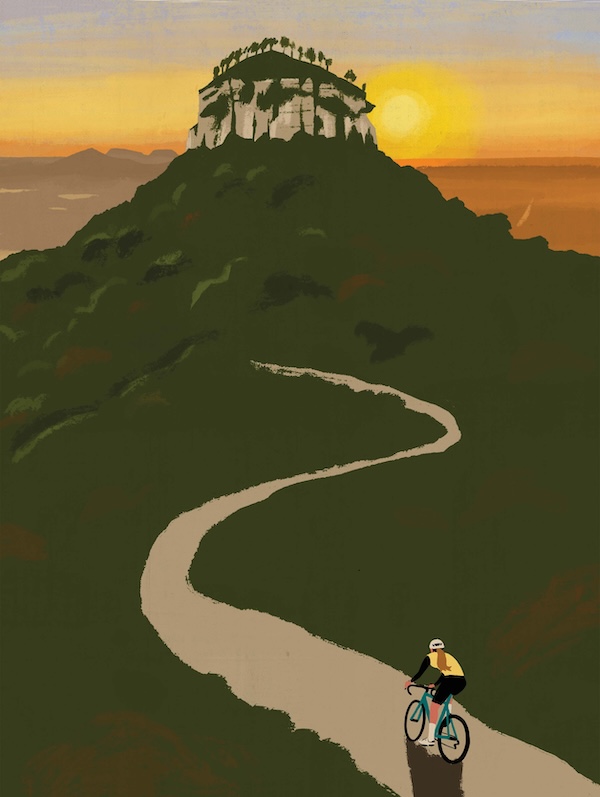
Ben Barnes (’20)
In 2022, Ben Barnes (’20) achieved a goal he’d been pursuing since he fell in love with kayaking as a kid: he became a national champion. Barnes spent his childhood summers on whitewater rapids, but he transitioned to flatwater kayaking as a teenager when he came across a long, skinny boat that could glide across lakes with ease. As soon as he sat in that sprint kayak, he started saving, and the next year he bought it.
He trained on his own for a while, growing in skill and obsession for the sport. During his junior year at Wake Forest, on a whim, Barnes decided to throw his kayak on top of his car and drive four hours to Lake Lanier in Gainesville, Georgia, the site of the 1996 Olympic flatwater events. Unannounced, he showed up to Lanier Canoe and Kayak Club’s training for nationals.
The team was surprised at the newcomer but recognized the boat as one previously owned by a former club member. The kayakers welcomed Barnes to paddle with them.
Barnes graduated from Wake Forest in 2020 into a pandemic world, allowing him to secure a remote job for a government contractor while living in Gainesville to train for that triumphal national championship with his team.
Shortly after the big win, Barnes got married and welcomed a son. Now, he has to find time to paddle while working full time and prioritizing his roles as a husband and dad.
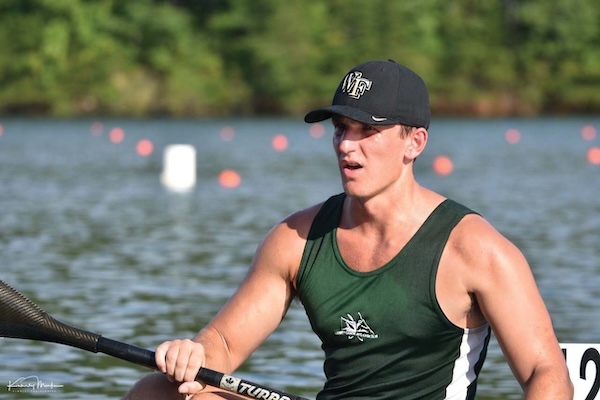
What’s one of your favorite kayaking memories?
I find a lot of beauty in the stillness of the lake. I’d paddle in the mornings and get there (to train) before the sun rose. … It’s completely flat, and there’s not even a ripple or a wave because there’s no wake. The sun rises as you’re paddling away from the boathouse. The sun is rising in front of you. I call it a “fire sky,” but if there are any clouds in the sky, they all light up, and it looks like you’re paddling into an orange sky. …
The boat doesn’t make any noise when it cuts through the water because it’s so pointy. It just throws off this little wave that is exactly the same the entire time. So you’re watching this constant wave as you go down the water. You only hear your paddle strokes, and you’re looking up and, at 7 o’clock in the morning, you have to wear sunglasses because the sun’s right in your face. It’s just majestic. … You get the sunrise in the sky, but then you get the reflection of the sunrise on the water.
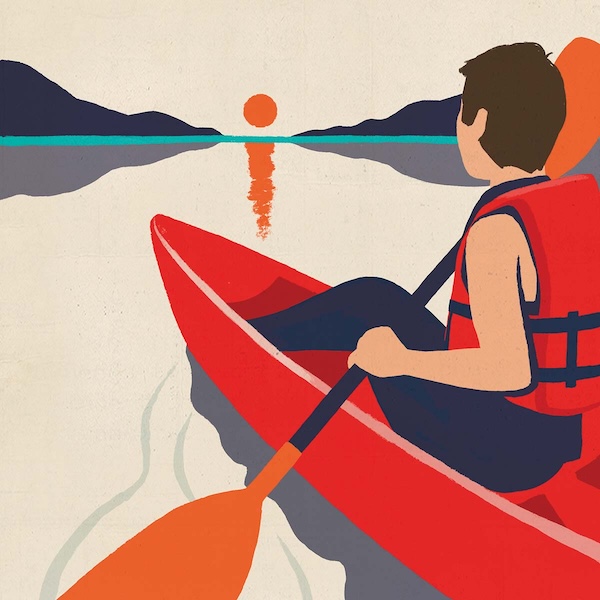
Tell me what it felt like to win a national championship race.
All of the training sessions, all of the hard work, everything culminates in a three-to-four-day regatta. … There’s a bunch of nervous energy, and then you get to the starting line. And for me, there’s just this sense of calm. But in actuality, I’m pushing as hard as possible on the water. …
That separation is really cool to me —the ability to mentally remove yourself while also remaining entirely focused on the task at hand. … And then that massive rush of everything coming back to reality and realizing that you won. I mean, there’s very little that compares to that.
What advice do you have for making time to kayak while balancing family and work?
Know that you need to schedule it in, because difficult things need to be scheduled in order to make the commitment to do them.
“The sun is rising in front of you. I call it a ‘fire sky,’ but if there are any clouds in the sky, they all light up, and it looks like you’re paddling into an orange sky.”
(Kayaking) will always give back to you. It’s always refreshing. You always come back in a better frame of mind. … Find that community that will do it at the level you want to do it at. I had to move to Georgia to find the community that will drive as hard as possible and become national champions. I guarantee you that there’s a Facebook group or a group of people around you that want to join on that journey and hold each other accountable.
Wendy Faulkner (’92)
Wendy Faulkner (’92) had wanted to go skydiving since she was 12 years old, when her family had planned to go watch her cousin do it. The dive was cancelled due to bad weather, but her interest remained.
“I remember all the adults sitting around talking about how he lives in a trailer at the airport and just drinks beer and eats fried okra. They all thought it was horrible, and I thought it sounded great,” she says.
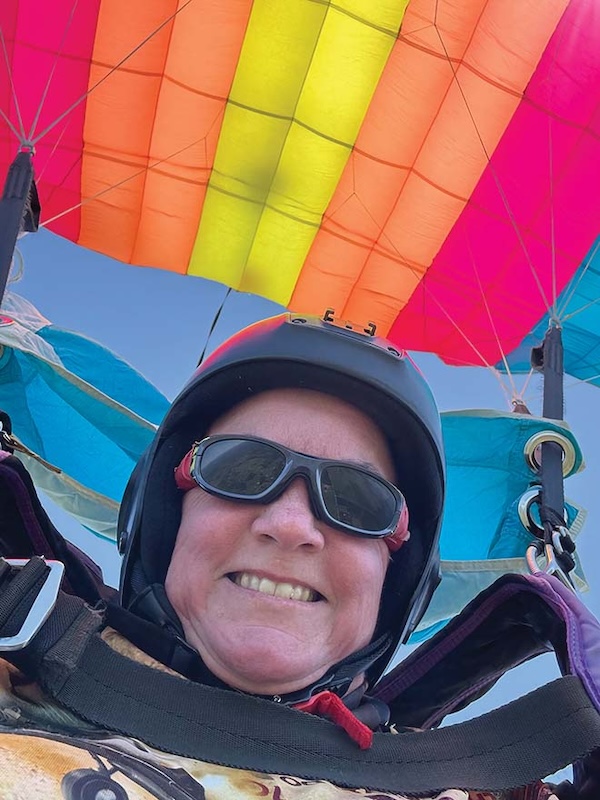
Fast forward to exam week during her first year of graduate school in math at Florida State University in Tallahassee. “I felt like jumping off something,” Faulkner recalls. “So, I looked up in the yellow pages where I could go skydiving. … I did two jumps my first day, and that was that.”
While working in tech in Austin, Texas, she managed to get in dives in Japan and the Swiss Alps. And in 2006, she quit to become a full-time skydiver, teaching lessons, taking video and packing parachutes to fund her passion.
More than 12,500 dives later, she’s still up for new challenges and adventures. She’s held hands in a circle of divers above pyramids in Egypt. She’s been part of mid-air formations that have broken world records.
Is skydiving scary? Or hard?
Definitely. Especially when you first start, you’re much more scared, then you get more experience. You learn to really manage your fear a lot. Certainly, you have to remain calm, even in tense situations. That’s why nowadays so many people just do tandems where you’re strapped to somebody. So, it’s less risk. If they completely freak out, there’s still somebody there who knows what they’re doing.
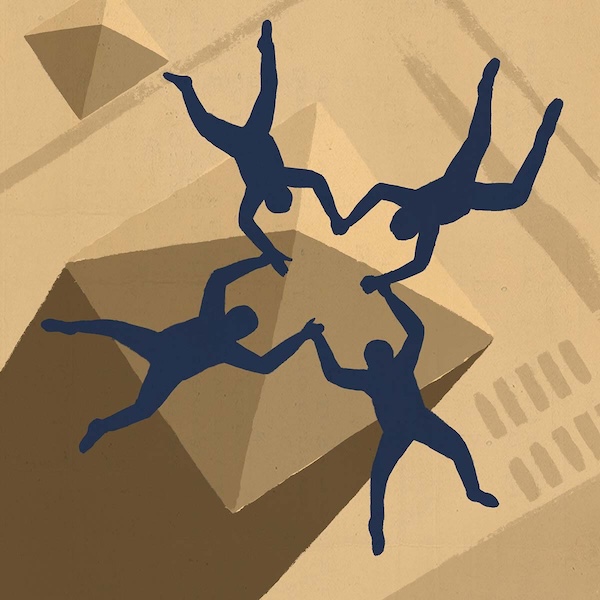
I was a very bad (skydiving) student. It took me forever to graduate from student status, but I had to do it the cheap way. I was earning $800 a month in grad school. I ate cheese sandwiches, and I lived in grad student housing for $200 a month.
What does it feel like before you release the parachute?
You learn to fly like a bird. It’s amazing just being able to do whatever you want to up there. A lot of people really like it because when you’re up there you can’t possibly think about anything else. You can’t think about your wife being mad at you or having to pay the mortgage next month or your brain. You just have to be in the moment.
We’re controlled, falling, but if you do feel like you’re flying, I might just see my friend over there, and I want to go to them. Once you get experienced and practice, you just know how to do it. You just go over there, and you don’t have to think about, “I have to move my arm a certain way, and I do this with my legs.” You just go walking.
It’s always a lot of fun jumping with your friends. I really got into the canopy formations, and a lot of my biggest memories are from that. But I’ll say that being in free fall over the pyramids of Egypt a couple of years ago was amazing. It was probably my coolest free-fall experience other than jumping out of a 727 jet.
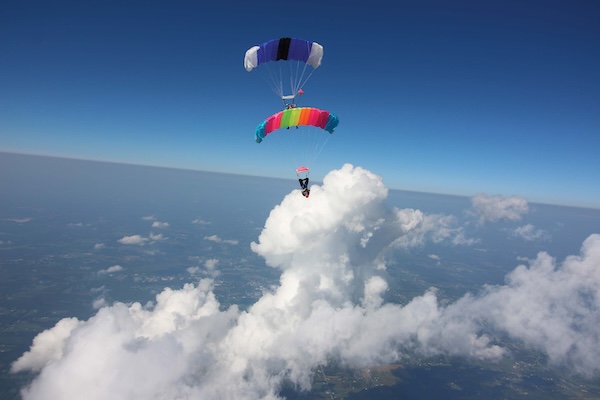
How do you have confidence that it’s not going to end badly?
We have altimeters (altitude meters), and most people these days not only have an altimeter on their wrist, they have one in their ear that gives indications of the right time (to release the parachute). And we always have two parachutes. So, if the first parachute doesn’t work for some reason, you have a backup.
You’re typically between 10,000 to 14,000 feet (when you jump out of the plane). There’s definitely less oxygen up there. If you’re only up there a few minutes, it’s not bad. But one of the world record attempts we did back in 2007, we had four or five planes, and we had to do a giant approach around Orlando. We were up there for 45 minutes at 14,000 feet, and most of us were very woozy. But the dudes from Colorado were fine. We did a canopy formation with 100 divers attached to one another flying through the sky and set a record. It was like a very slow-moving jet on the radar, apparently.
The landings are where a lot of people get injured. The main people who get injured are doing what’s called “swooping.” People want to come in super fast, and they do turns low to the ground to pick up even more speed when they come in. It looks cool, but if you screw it up, you can easily injure yourself for life or die.
You’ve set world records. Do you still find new ways to challenge yourself?
Definitely. I still want to jump in Australia. That will be my sixth continent.
Ella Bruggen Filston (’20) and David Filston (’20)
Hiking has been a throughline in the lives of Ella Bruggen Filston (’20) and David Filston (’20). Both grew up with parents who instilled in them a love of the outdoors, and the couple first connected during their adventures through Wake Forest’s Outdoor Pursuits trips. They’ve shared many hiking adventures together, from one of their first dates hiking at North Carolina’s Hawksbill Mountain near Linville Gorge to a tough 16-mile trip in the Tetons in Wyoming after they were married.
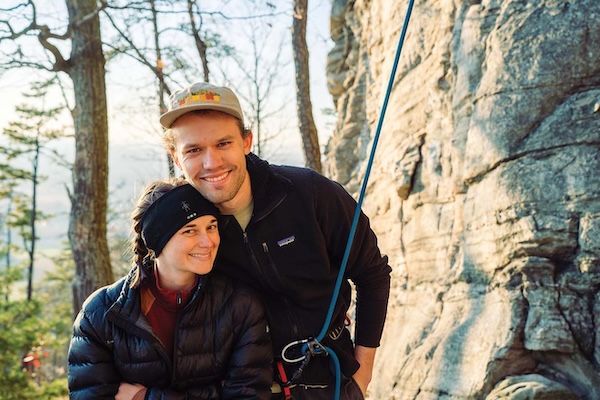
Their past four years in Athens, Georgia, have been busy — between David’s medical school classes and Ella’s full-time job and nighttime graduate school classes. But they’ve found that taking time for their favorite hobby rewards them in moments of joy, connection, reflection and mental wellness. When they’re hiking, they say, time even seems to slow down.
Earlier this year, when ranking David’s options for residency programs, their pro-con sheet included a priority: how close were accessible outdoor spots? The couple landed in Charlottesville, Virginia, where several Shenandoah hikes and swimming holes are on their bucket list. As David says, “Every trail is something new to discover.”
Did you have a favorite hike near Wake Forest?
David: What I love about Pilot Mountain is you can just drive to the top and go on a flat hike from there, or you can start at the bottom and have a lot more elevation gain and distance and a winding path all the way to the summit. I have so many memories of going for a sunset there and walking around, climbing with friends and family and leading (Outdoor Pursuits) trips there.
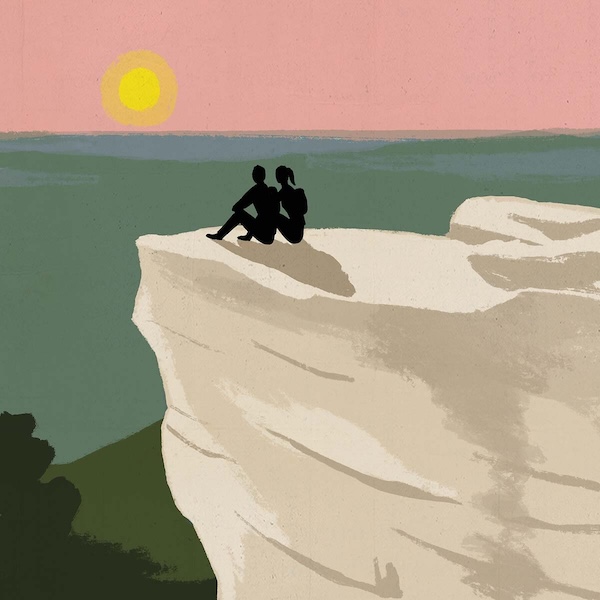
Ella: One time we just got Chipotle and just drove to the top and sat and watched the sunset. So, we actually didn’t put in any work there, and it was still really good for us.
What are the benefits of hiking?
David: It’s cool to see what you can do. Looking back — sometimes you get a view of where you parked — and getting to see how much you did. Or not knowing if you’re going to make it or not knowing what lies ahead.
Ella: Sometimes you have to keep going — you just have to — or you won’t reach water or you won’t reach the car. …
I think it’s especially empowering for people who are often told they can’t do things, like women or other identities. It can be very empowering to be like, I planned this whole trip myself. I fed myself. I got from point A to point B.
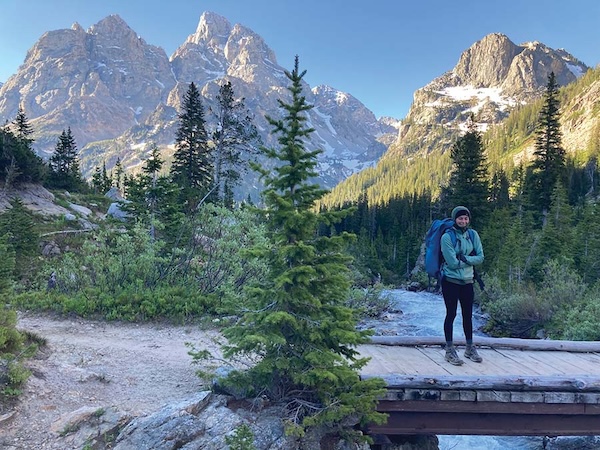
David: I’ve enjoyed a lot of solo hikes. Being alone and away from distractions, for me, has been a good time to reflect and get some clarity on things, whether it’s a big life decision or my brain feels like a mess.
Ella: I, for sure, think life gets simpler, and your senses get stronger, outside. …
I think the mind-body connection is stronger outside. I hate peanut butter and jelly sandwiches unless they’re on a hike.
What advice do you have about making time to hike, even when life is busy?
Ella: A hike doesn’t have to mean (that you) drive two hours to go to the top of a mountain. I’m lucky to have a trail near my office building, so I just pace around on that trail sometimes.
David: You don’t have to hike the whole AT (Appalachian Trail) to discover yourself. You can just take a minute after work and relax a little bit.
Ella: It’s really hard to choose these things in the midst of chaos. … It’s going to be inefficient and inconvenient when you choose to do it, but the payoff is big and lasting.
Donna Edwards (’80)
Former U.S. Rep. Donna Edwards (’80), D-Md., became the first Black woman to represent Maryland in Congress in 2008. She set out to continue her life in public service when she ran for U.S. Senate in 2016, but she lost. Couple a grueling campaign with a diagnosis of multiple sclerosis that year, and Edwards knew after finishing her congressional term in the new year she needed a break.
On Jan. 5, 2017, she hit the road with “Lucille,” the name Edwards gave a friend’s RV she borrowed for that first trip. The moniker honors Lucille Ball in the 1954 movie, “The Long, Long Trailer,” about a comically disastrous RV trip taken by Lucy and Desi Arnaz — not, as many assume, the B. B. King song.
The exhausted congresswoman’s ramble was meant to last two weeks but extended into April, 45 states and 12,000 miles. Starting in Florida, Edwards zigzagged across the South to Joshua Tree National Park and Death Valley and onward to Utah and Colorado. She eventually wrote about her experiences in The Washington Post.
Today, Edwards motors around in Lucille 2, her own 24-foot RV. She loads up her cat named Midnight, her fishing rod — “I love to fish” — and her supplies. Off she goes to KOA campgrounds, to U.S. Army Corps of Engineers properties along rivers and to U.S. and state parks and out-of-the-way national forests where the temperatures drop to Edwards’ liking. From her home in Maryland, she’s motored to Alaska and back.
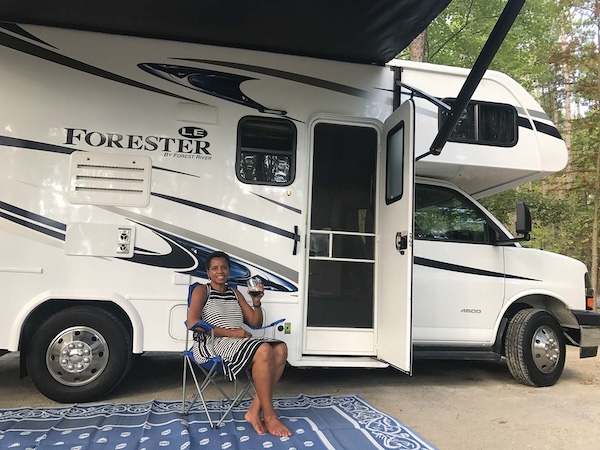
The Parks Channel streaming app will air a segment at some point about the joy Edwards finds on the road in her RV. She’s loved the camping life since she was a child growing up in an Air Force family. The kids jumped into the back of the station wagon, and the family embarked on adventures. From the time Edwards was young, she dreamed of having an RV.
She counts on more adventures ahead. A Wake Forest trustee, a Distinguished Alumni Award winner and a member of nonprofit boards, she is also a political commentator on MSNBC, ready to broadcast, even when she’s RVing, if there’s good Wi-Fi nearby.
What value do you find being outdoors?
For me, it’s about decompressing. … After serving almost 10 years in Congress, I was exhausted. I started my mornings at 7:30, with meetings going to 11 o’clock at night. And so, to be outdoors for me was a way of just separating myself from the rest of the world.
And people ask me all the time, “Don’t you get lonely?” I really do not. I look around. I see what’s around me. I hear all the birds — all of them. It’s like you actually hear their different conversations.
One time driving down to Key West, …at night I just put my blanket out, and I just slept on the sand, and I could just look up at the sky. And you could hear the water lashing up against the rocks. It’s a way to separate yourself.
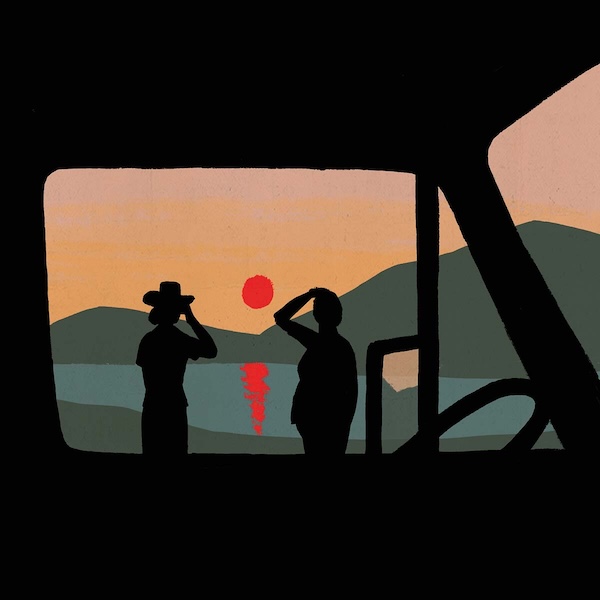
What do you enjoy at the campgrounds?
Every single person there has that one thing in common. They may not have anything else in common, but that’s one thing they have. … It puts you at this kind of granular level, where you are just seeing people at their very basic place: “This is the thing I love. I like being out here in the woods and the trees and looking at the ocean. And that person right there likes the same thing.” And that’s it. And then people talk about how many parks they’ve been to and where was their favorite park and what route they took. And they talk about their rigs a lot.
You hiked in Utah at Arches National Park to the top of a peak with your cane. Tell me more about the victories.
From 2016 until now, my disability and mobility challenges have increased tremendously. And I’m still trying to figure out a way that I can best enjoy the things that I enjoy. And I’ve discovered I have so much regard for the park rangers, … because my first stop whenever I arrive someplace is the visitor’s center or the ranger’s office to talk to them about what’s accessible. … They’re so good at helping me figure out how I can enjoy the park. Lots of people have mobility challenges, whether you’re traveling with an infant on your back, or you’re a senior or somebody like me with a chronic disease. You still want to be able to enjoy all that these parks have to offer and not feel like you’re limited because your mobility is limited.
People see me get out of the RV, and I’m like, I have a lot of upper body strength. And so, my legs may not work, but I’m pulling myself out of the RV, and (people) are looking at me, and they’re shaking their heads. … What do I say: As much as I can as best as I can for as long as I can.
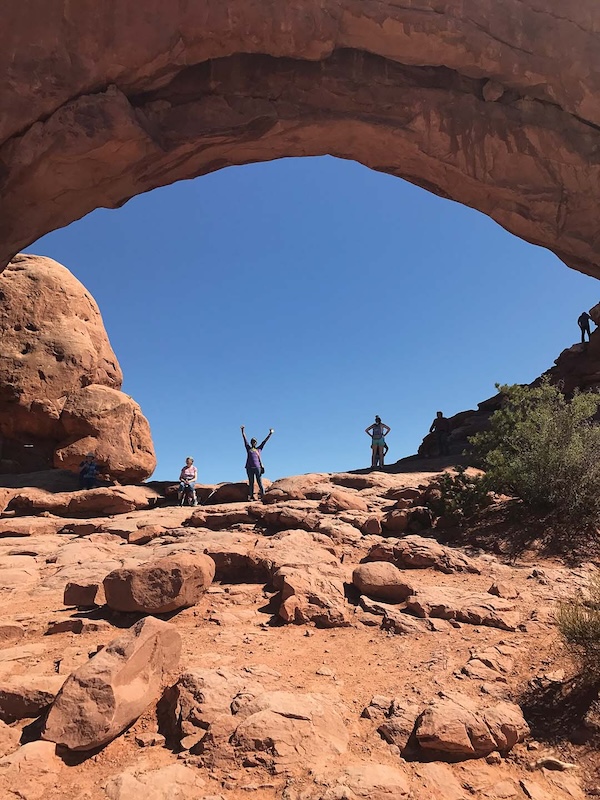
Damani Mitchell (MBA ’24)
Damani Mitchell (MBA ’24) has spent more time crisscrossing the Reynolda campus as a runner than he did as a School of Business student. While working on his MBA and also holding down a full-time job, he rarely ventured far from Farrell Hall.
On Saturday mornings these days, it’s a different story. After spending the work week as a manufacturing engineering supervisor for Collins Aerospace, Mitchell laces up and joins a faithful group for a “no-drop” run, meaning no one gets left behind. He and his running buddies start in Reynolda Village, head down the trail to Reynolda campus and take in its beauty in every season. (More on that below.)
The meet-up, organized through the local Twin City Track Club, means so much to Mitchell that he recently ran for and was elected as the club’s vice president.
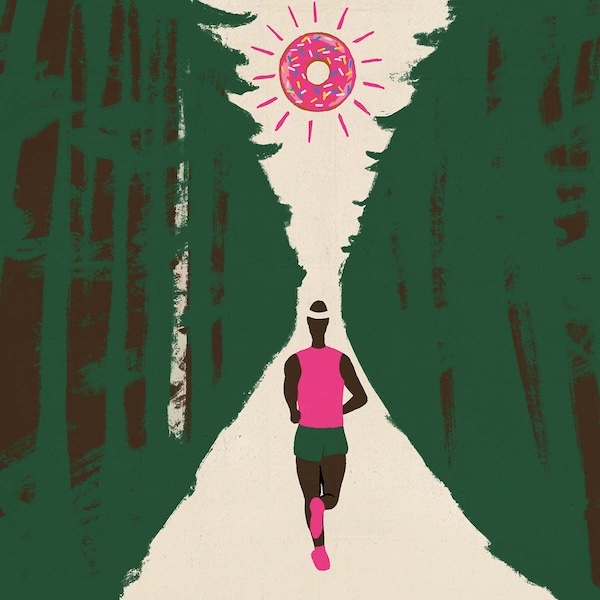
How did you get into running?
I’m not, let’s say, super competitive in sports. So running was a good activity I could do growing up that kept you active without having to find a team and constantly trying to get better. And it also just really puts you at peace. So, me and my family, we lived near the sea (in Kingston, Jamaica), and we would go for runs along the beach.
And then I would kind of run in between classes in college (at Embry-
Riddle Aeronautical University in Daytona Beach, Florida). And then I kicked it up after I graduated. I was living in West Virginia, and it was gorgeous along the Greenbrier River Trail. I would go there a couple times a week, and the more you run, it becomes easier, and you hit new milestones.
One day, I set a goal of being able to run a 10-mile stretch. I’d never run that much before. I’d run a whole bunch of fours and sixes and one day I got to about six miles, and I’m like, “Let’s just keep going.” I got to eight that day, and I was like, “Man, maybe I could have done the 10.”
My first race was a 10K called the Chocolate Chase, and it was at the Lewisburg (West Virginia) Chocolate Festival. At the end of the race, they have chocolate bacon and Nutella on burgers. So, my first race was very, very memorable.
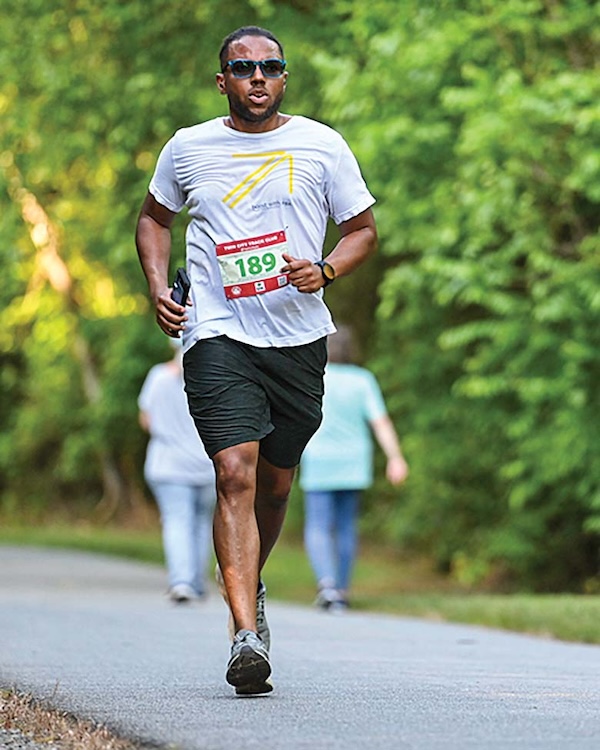
And then you found a running group in Winston-Salem?
When I moved six years ago, I saw there was a running club, and I thought that would be something interesting to be involved with. We go through Reynolda Gardens. We start off the Saturday run uphill into campus, and we run right past Farrell Hall. It’s like a homecoming every Saturday.
And you will see a theme here: I love donuts so in 2020, I signed up for the Krispy Kreme Challenge at NC State University. (Runners go 2.5 miles, eat a dozen donuts, and run 2.5 miles back.) It was just thousands of boxes of donuts.
(His first half marathon was Winston-Salem’s Mistletoe Run in 2022, and he ran it again in 2024.) We runners can fake ourselves into a half marathon. If you can get past a couple miles, you can get up to that 13. But I can tell you, I was pretty much done at 11.
“I broke so many personal records because we’d go in, it’s a five-mile run normally, and somebody says, ‘Hey, let’s just go run three more.’”
I’m going to give credit to the track club. Because of that Saturday morning run, I have run my longest runs, hottest runs, coldest runs, earliest runs. I broke so many personal records because we’d go in, it’s a five-mile run normally, and somebody says, “Hey, let’s just go run three more.” I’m like, “OK.” And then last year when the wind chill made it feel like it was 17 or 18 degrees, they still had 12 people show up.
My hands don’t generate warmth. I found these rechargeable electric handwarmers. I turn those on, and I set them in my gloves. That way, we’re going to have a much better experience.
What’s your advice for people who want to get into running?
The group dynamic really helps. A lot of people show up consistently because they know everybody else is going to be there, and we end with the donuts.
There are always treats at the end. Motivation is very, very important. So, I try
to help people not look at it as one long, big, fast run that you can’t do. It’s more
of a couch-to-5K approach. You break this big thing down into what’s actually not that many small things. That really, really helps.
Lydia Laboccetta (’97)
Dr. Lydia Toon Fleury Laboccetta (’97) has been spearfishing since the late 1990s and holds two world records for women for the largest amberjack catch and largest hogfish catch. “Interacting with ocean life,” she says, is like going to “a different planet.”
She was introduced to spearfishing during a post-graduation trip to the Bahamas and honed her skills when she met her future husband, an avid spearfisher. She can frequently be found spearfishing around Frying Pan Tower, about 30 miles off the North Carolina coast.
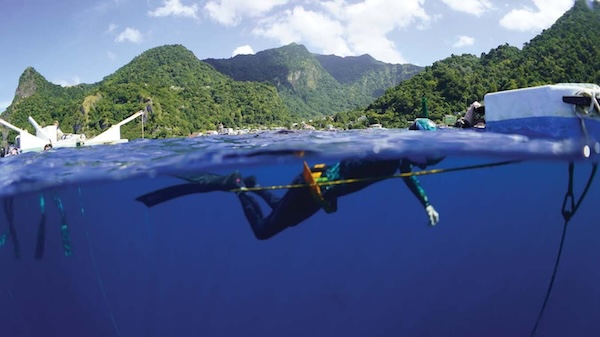
A theatre major at Wake Forest, she pursued an acting career and was an assistant professor in wardrobe design at the University of North Carolina Wilmington for several years. Her late grandfather’s pancreatic cancer diagnosis sparked an interest in medicine, and she earned her medical degree from Eastern Virginia Medical School. She is a urologist at Novant Health Brunswick Medical Center outside Wilmington.
How did you get into spearfishing?
I grew up trolling for Spanish mackerel off the shore of Wrightsville Beach (North Carolina) with my dad. We’d go deep sea fishing, and you could see all the fish, but nothing would bite. And I’d say, “Can’t we just get in the water and shoot one and go home?” Then when I got into spearfishing, I learned, “Yes, you can.”
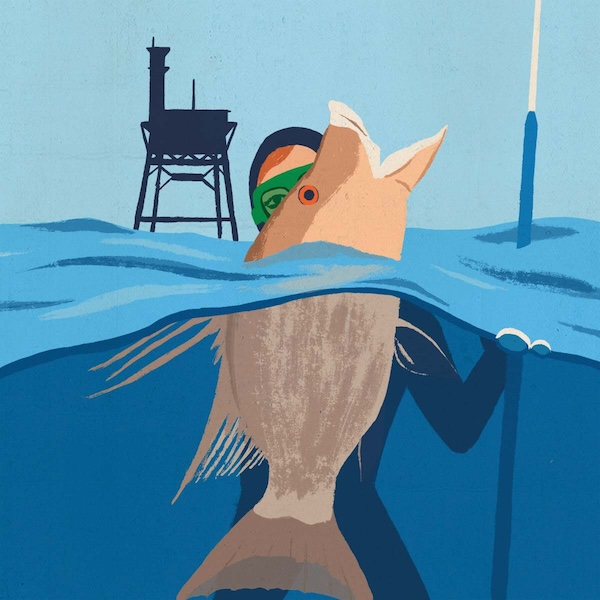
What are the benefits?
My two daughters, 7 and 9, have gotten into freediving and are really comfortable in the water. The other thing I’ve loved is introducing a lot of my girlfriends to it. It’s a very intimate camaraderie. When you’re buddy diving, you’re 100% eyes on (your buddy). You’re not checking your phone. You are that person’s lifeline.
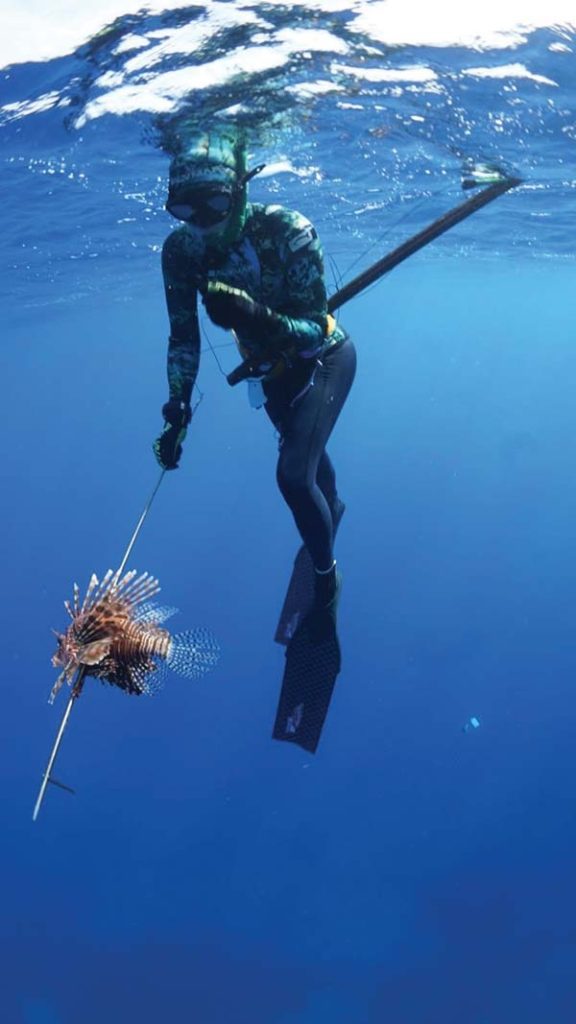
To spearfish well, you have to freedive well, and you have to have a singular, very calm focus. It’s given me the ability to really, really, really center myself and calm myself. If you’re amped up, then you’re wasting your oxygen. (She has freedived as deep as 102 feet and has held her breath for up to four minutes and 30 seconds.)
As a mom and a surgeon, I can’t really get away, but no one can reach me underwater. My only role in that moment is to find the fish, shoot the fish and come to the surface alive.
What is a favorite memory or two?
Amberjacks, or reef donkeys, are very curious fish, and when you dive, they follow you. Then when you come up, there’s almost like a tornado (of fish) around you. Last summer, my 9-year-old dove down 25 feet, and when she came up she was just surrounded by amberjacks. To see that as a mom was beautiful. I once accidentally went swimming with a great white shark.
I thought (at first) it was a sand tiger shark. It was interesting to see its behavior, just kind of hanging out, not at all aggressive, just living its life.
What advice would you give to someone interested in spearfishing?
Get a guide. Having somebody who is an expert in whatever you want to do is a worthwhile investment. Whether you shoot a fish or not, you’re going to have an epic experience. If you have someone who is showing you the ropes, they’ll tailor your experience to your comfort level.
Sherry Lee (’91)
Sherry Russ Lee (’91) has loved bicycles since Santa brought her the shiny, red Raleigh 10-speed she rode down Reynolda Road to the Village Soda Shop for milkshakes.
As she grew older, Lee found her interest in cycling shifted from the destination to the journey. She asked for a cycling tour in Washington state as her graduation present — a trip that was cut short when she was hit by a car, badly injuring her back.
Lee put the brakes on biking after that, focusing instead on recovering, getting married and earning a master’s degree in sociology at the University of Georgia in Athens. That led to a lifelong career in human resources, first in Atlanta and then in Winston-Salem. Moving home also brought her back to cycling — this time, with her husband, Mitch Lee.
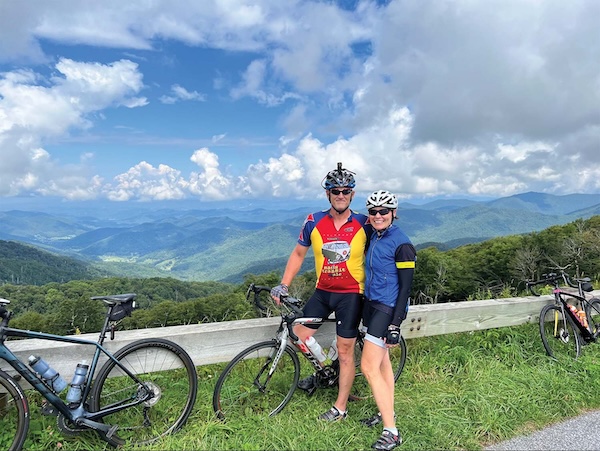
Their passion has taken them on country roads from North Carolina and many parts of the United States to Italy, Canada, France and Croatia, often in the company of friends. They once celebrated their wedding anniversary by buying a tandem — a bicycle built for two. But they soon learned that it worked best for the occasional social outing.
How did you get into cycling?
I bought a used bike from somebody when we were at Wake and started riding it a little bit. Then after we moved back (to Winston-Salem in 1998), Cheryl Van Riper Walker (’88, P ’21) and Scott Walker (P ’21) got us to do the Tour to Tanglewood, which benefits MS (multiple sclerosis).
It was the beginning of the major obsession. One of the reasons I love cycling is because it’s one of the few times when I’m completely in the moment. The distractions fall away. I have my phone with me for safety, but it’s not pulling at me — except the one time I pocket-dialed my boss.
What are the benefits?
For us, cycling is physical, mental; it’s social. It captures the feeling of when you’re 10 years old. It’s freedom, it’s the wind in my face, it’s the feeling that there’s something bigger out there beyond you. The virtual world can’t compare. It’s a real gift to be able to pause and experience the natural world in whatever way, shape or form.
And we have found all the professional services we would ever need through cycling, from bricklayers to physicians and attorneys. That’s how we got our back patio and retaining wall built.
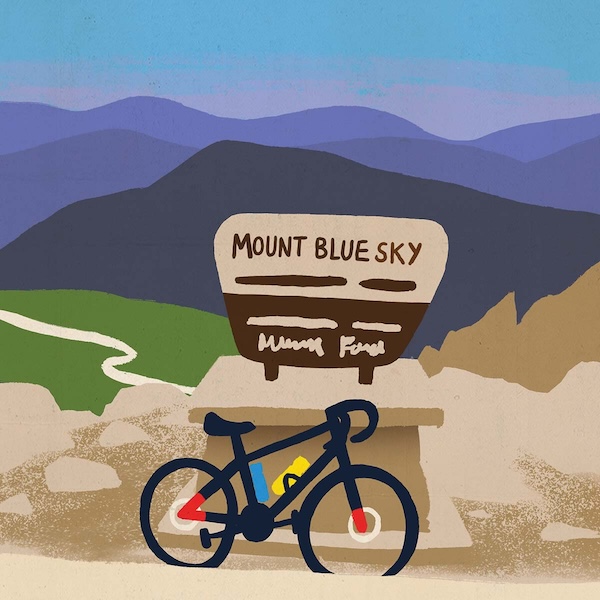
You’ve been cycling for decades. What keeps you motivated?
I love the sense of accomplishment. I remember the first time I climbed Pilot Mountain. It’s two miles. It is a grind. The first time I climbed it, it was a ride where you climb Sauratown, Hanging Rock — and you get to Pilot Mountain at mile 58. That’s a favorite. I always stop and look out over the overlook at the top of the parking lot, because you have to pause and take it in.
The other big sense of accomplishment I remember is when I got to the top of Mount Evans (now called Mount Blue Sky) in Colorado, which is 14,000 feet. The first time I tried it, at 10,000 feet I started getting the lightheadedness that is the precursor to altitude sickness. I didn’t want to push it before coming back down on a road with no guardrails. When I did it again, I made it to the top.
I would much rather go uphill than down. Mitch likes to go much faster than I do. I always just pray I’m not going to find him in a heap by the side of the road when we get there.
I have been in over my head more than once. It’s a really good opportunity to challenge myself and to know that I can do it. Like, going up Mont Ventoux in Provence last summer. I was up the night before throwing up at 2 a.m., not sure if I could do it. (She did.)
It’s a way to challenge myself, to get physical activity, a great source of friendships and a way to see the world.
Interviews have been edited for length and clarity.
